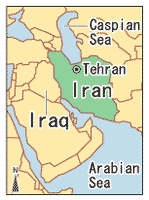(27)People in Iran still suffer from poison gas by Shizuko Tsuya
Like the Peace Memorial Ceremony held every year on August 6 in Hiroshima, a Peace Ceremony is held in Iran on June 29 with the hope of abolishing all chemical weapons. The destruction wrought by the atomic bombings of Hiroshima and Nagasaki is widely known around the world, but there is little awareness of the damage caused by poison gas in Iran. In 2004, I took part in the Hiroshima Peace Mission which traveled to Iran. At that time I first heard about the country's struggle with poison gas.
During the Iran-Iraq War (1980-1988), the people of Iran were attacked with poison gas and about 6,000 died. Today, roughly 55,000 survivors of these attacks are still suffering from the aftereffects.

The Memorial for Poison Gas Victims in Tehran. (photo from MOCT, taken on June 29, 2007)
Shizuko Tsuya
Shizuko Tsuya is head of MOCT, an NPO in Hiroshima. Inspired by the work of Dr. Marcel Junod for the International Committee of the Red Cross, she founded MOCT in 1994 to provide medical services overseas. MOCT has also delivered support to children's hospitals in Russia, Belarus, and Ukraine, and refugees in Chechnya. Ms. Tsuya was born in Niigata Prefecture and now lives in Hiroshima.
During our stay in Iran, I heard the people's hopes: "We want to conduct research in cooperation with Japanese universities" and "We want the world to know the facts of this tragedy." As a result of this experience, our group, MOCT, was determined to help. In 2004, we began inviting Iranian sufferers of poison gas to the Peace Memorial Ceremony in Hiroshima and we returned to Iran on June 29 to visit the sites that had been attacked with poison gas.
Victims of poison gas are difficult to distinguish by their appearance, but they are plagued by damage to their respiratory system and these disorders are impossible to cure completely. When we first met them, they seemed very depressed and rarely smiled. However, in the time we have known them, their outlook has gotten brighter and they even smile more. For us, this improvement is our greatest joy.

On June 29, 2007, a memorial for the poison gas victims, along with a Peace Museum, was completed in a park in Tehran, the capital of Iran. These facilities were established by the city of Tehran and a group of survivors, but 600,000 yen of the total construction cost of 3,600,000 yen was donated by individuals and groups in Hiroshima through our interaction with the people of Iran.
This memorial was inspired by monuments in Hiroshima Peace Memorial Park and includes a large statue of a white crane. In the Peace Museum, photos of the destruction caused by the atomic bombings of Hiroshima and Nagasaki, as well as the damage done by poison gas in Iran, are on display.
I often recall the words of the Director of Hiroshima Peace Memorial Museum, Koichiro Maeda, who welcomes our visitors from Iran every year. I am happy that the new museum in Iran was named the "Peace Museum" instead of the "Poison Gas Museum," he said. "It seems Hiroshima's spirit of wishing for peace has made an impact there."
In addition to Hiroshima's mission of conveying the reality of the atomic bombing, I feel the city has another important responsibility, too, that of delivering hope and compassion to people elsewhere who suffer from war and misfortune. The name of our organization, MOCT, means "bridge" and we will continue trying to be a bridge of love to others.